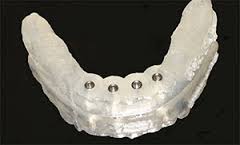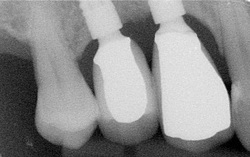"The First Thread Club"®
"If The Bone Stays Home, Or Gets Grown, You Get To Pick Your Own"®
Read on to find out more
Overview

The use of implant supported prostheses in the treatment of partial and full edentulism is now a well accepted modality that has documented success rates of up to twenty years which surpass more traditional methods. When one, several or all of your patient's teeth are missing, implants supporting crowns, bridgework or full dentures can be the best option for replacing them, both from a functional and an esthetic standpoint. Many implant systems are available for this purpose, each with unique features. The restorative dentist, as the architect of implant treatment, must lead the implant team (including the dental laboratory, implant surgeon and implant manufacturer) from start to finish. Newer technologies, such as cone beam tomography, greatly facilitate this responsibility.

Dental implants may be placed in both dual and single stage procedures or immediately after extraction, depending on the clinical conditions present. Restorative considerations must always drive treatment planning before the surgical phase of implant placement begins and it is the restorative dentist’s responsibility to guide and inform the surgeon with respect to these factors, as it is the restorative dentists who are ultimately accountable for the final outcome over time. System selection as well as certain pre and peri-prosthetic measures can be taken to enhance the result of treatment with respect to both the soft tissue architecture framing the restoration and the final product produced by the dental laboratory. The conical implant/abutment connection has changed the way I treatment plan implant cases, as it eliminates the bone loss (euphemistically referred to as "remodeling") often seen with connection types used in other systems that leads me to refer to them as members of "The First Thread Club"®. The resulting outcomes I have been able to achieve with the conical connection are truly superior to what I had in the past. While some say "The Tissue Is The Issue, But The Bone Sets The Tone", I say "If The Bone Stays Home, Or Gets Grown, You Get To Pick Your Own"®, referring to the abutment design and restorative material choices afforded by the osseous promoting properties of the conical implant/abutment connection.
Learning Objectives
After this course, the attendee should be able to:
- Identify the three different types of surgical procedures used to place single tooth implants and how to treatment plan from among these for the most desired result.
- Describe the different features that implant systems have and their significance to both the surgical and restorative processes as well as the final clinical result.
- Discuss the importance of pre and peri-prosthetic measures on the esthetic results of these cases and how implant system selection affects that choice.
- Explain the restorative dentist’s role as the architect of all phases of patient care in these cases and his or her ultimate responsibility for the final result over the long term.
